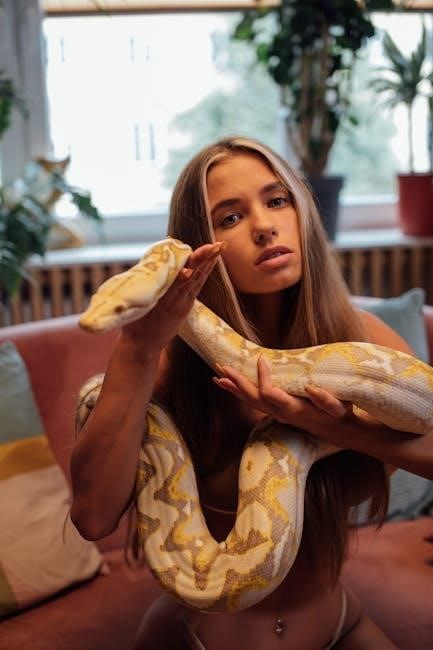Ball Python Morphs: An Ultimate Guide
Welcome to the ultimate guide exploring the fascinating world of ball python morphs! Discover the unique physical appearances, genetics, breeding techniques, and care essentials for these captivating snakes․ Whether you’re a seasoned breeder or a curious newcomer, this comprehensive guide has something for everyone․
Ball python morphs represent the diverse array of colors and patterns found within the species, deviating from the typical “wild type” appearance․ These unique traits arise from genetic mutations, which breeders carefully cultivate through selective breeding programs․ The result is a stunning collection of ball pythons exhibiting an astonishing variety of visual characteristics․
This guide will navigate you through the captivating world of ball python morphs, encompassing their genetic origins, popular varieties, and essential care requirements․ Whether you’re an experienced herpetoculturist or a beginner, this resource offers valuable insights into understanding and appreciating these remarkable reptiles․
Delve into the realm of morphs, where color variations range from striking albinos to mesmerizing axanthics, and patterns transform from classic pinstripes to intricate spiderwebs․ Learn how these traits are inherited, how to predict the outcomes of breeding projects, and how to provide optimal care for your ball python morphs․ Prepare to be amazed by the sheer diversity and beauty of these incredible creatures․
Understanding Ball Python Genetics
The foundation of ball python morphs lies in genetics․ Each morph is the result of specific gene mutations that alter the snake’s appearance․ These genes can be either dominant, co-dominant, or recessive, dictating how they are expressed in offspring․ Understanding these inheritance patterns is crucial for breeders aiming to produce particular morph combinations․
Dominant genes, like those responsible for the Pinstripe morph, only require one copy to be expressed․ Co-dominant genes, such as those for the Mojave morph, result in a different phenotype when present in single or double doses․ Recessive genes, like Albino, require two copies for the trait to manifest․
Genetic notation is used to represent these genes, allowing breeders to track and predict offspring traits․ For instance, a heterozygous Albino (carrying one copy of the Albino gene) is denoted as “Het Albino․” A visual Albino has two copies of the gene․ Mastering these genetic principles unlocks the potential to create a dazzling array of unique ball python morphs․
Key Terminology in Ball Python Morphs
Navigating the world of ball python morphs requires familiarity with specific terminology․ “Morph” itself refers to a distinct visual variation caused by genetic mutation․ “Gene” is the unit of heredity responsible for a particular trait, while “allele” is a variant form of a gene․
“Homozygous” means an individual has two identical alleles for a gene, while “heterozygous” means they have two different alleles․ A “visual” morph displays the trait associated with its genes, whereas a “het” (heterozygous) carries a recessive gene without showing it․
“Co-dominant” genes express both alleles, creating a unique phenotype․ “Super form” refers to an animal with two copies of a co-dominant gene․ “Line breeding” involves selectively breeding related animals to enhance specific traits․ Understanding these terms is essential for effective communication and successful breeding projects within the ball python morph community․
Popular Ball Python Morphs: Top 50
The world of ball python morphs is incredibly diverse, with thousands of variations․ Narrowing down the most popular is challenging, but several stand out due to their striking appearances and established presence in the reptile community․ Albino, with its complete lack of melanin, displays a bright white and yellow coloration․
Spider morphs, recognized by their unique pattern distortions, remain highly sought after․ Pinstripe morphs feature a clean, unbroken dorsal stripe, while Mojave morphs exhibit a reduced pattern and striking eye color․ Banana morphs, known for their vibrant yellow spots, are also popular․
Other notable mentions include Pastel, Enchi, Leopard, Clown, and Fire morphs․ Combinations of these genes create even more stunning variations․ The Super Orange Dream Leopard DG Pied is a prime example of complex combinations․ This list only scratches the surface, but it provides a glimpse into the captivating diversity of ball python morphs․

Color Morphs: Albino, Lavender Albino, Axanthic
Color morphs in ball pythons dramatically alter the snake’s pigmentation, creating visually stunning variations․ The Albino morph is perhaps the most well-known, characterized by a complete lack of melanin, resulting in a white and yellow snake with red eyes․ This recessive gene eliminates dark pigments․
Lavender Albino is another captivating color morph, also lacking melanin, but exhibiting a beautiful lavender or pale purple hue instead of bright yellow․ This subtle difference makes it a prized morph among collectors․

Axanthic morphs, on the other hand, lack xanthophores, which produce yellow and red pigments․ This results in a grayscale or black and white snake․ These three morphs showcase the power of genetic mutations to transform the color palette of ball pythons, highlighting the diversity within the species․ They are highly prized․
Pattern Morphs: Spider, Pinstripe, Mojave
Pattern morphs in ball pythons revolutionize the snake’s design, creating unique and intricate visual appeals․ The Spider morph is instantly recognizable for its reduced pattern and “spiderweb” effect on the dorsal area, though it’s associated with neurological issues․ The Pinstripe morph features a clean, unbroken stripe running down the length of the snake’s back, simplifying the typical pattern․
The Mojave morph is known for its enhanced blushing, reduced pattern, and intense coloration․ It often results in a “cleaner” appearance compared to the wild type․ These pattern morphs demonstrate how genetic variations can lead to a wide array of aesthetic differences, making each ball python truly unique․
Breeders often combine these pattern morphs with color morphs to create even more visually striking and desirable combinations․ Each morph carries its own set of unique characteristics․
Combination Morphs: Mojave Spider, Super Orange Dream Leopard DG Pied
Combination morphs represent the pinnacle of ball python breeding, blending multiple genes to produce snakes with astonishing visual traits․ The Mojave Spider combines the clean patterns of the Mojave with the unique web-like markings of the Spider morph․ However, breeders must be aware of the Spider morph’s potential neurological issues․
The Super Orange Dream Leopard DG (Desert Ghost) Pied is a complex combination, showcasing vibrant colors and intricate patterns․ Super Orange Dream enhances the orange hues, while Leopard introduces spots and freckles․ The Desert Ghost gene reduces dark pigmentation, and Pied adds patches of white, creating a stunning contrast․
Successfully breeding these combination morphs requires a deep understanding of genetics and careful planning․ The results, however, can be truly breathtaking, yielding some of the most sought-after and visually striking ball pythons in the reptile hobby․
Breeding Ball Python Morphs: Techniques and Prediction
Breeding ball python morphs involves understanding genetics and employing specific techniques to produce desired offspring․ Selective breeding, based on dominant and recessive genes, allows breeders to create snakes with unique color and pattern combinations․ Accurate record-keeping is crucial, documenting parentage and traits․
Incubation plays a vital role, with perlite or vermiculite often used as a medium․ Maintaining optimal temperature and humidity is essential for successful hatching․ Predicting morph outcomes requires knowledge of Punnett squares and genetic probabilities․
Understanding co-dominant and incomplete dominant genes is also important, as they can result in offspring expressing traits differently than either parent․ Responsible breeding practices prioritize the health and well-being of the snakes, avoiding pairings that may result in genetic defects or reduced quality of life․ Careful planning and research are key to successful and ethical ball python morph breeding․

Care Essentials for Ball Python Morphs
Providing proper care for ball python morphs is essential for their health and well-being․ A suitable enclosure with appropriate temperature gradients is crucial․ The warm side should be around 88-92°F, while the cool side should be around 78-80°F․ Humidity levels should be maintained between 50-60%․
A secure hide on both the warm and cool sides allows the snake to feel safe and secure․ A water bowl should always be available for drinking and soaking․ Feeding appropriately-sized prey items, typically rodents, is vital for proper nutrition․
Regular handling can help acclimate the snake to human interaction․ Monitoring for signs of illness, such as respiratory infections or scale rot, is important for early detection and treatment․ Providing a stimulating environment with climbing opportunities and enrichment items can enhance the snake’s quality of life․ Proper sanitation and hygiene are essential for preventing disease․
Potential Problems When Breeding Certain Morphs
Breeding ball python morphs can be exciting, but it’s crucial to be aware of potential problems․ Certain morph combinations can result in offspring with health issues or deformities․ The Spider morph, for example, is associated with a neurological condition known as “wobble,” which affects the snake’s balance and coordination․

Breeding two Spider morphs together can result in offspring with severe wobble, making it difficult for them to eat or move properly․ Other morphs, such as the Super Cinnamon and Super Black Pastel, can also produce offspring with kinking or other deformities․
Careful research and planning are essential to avoid these issues․ It’s important to understand the genetics of the morphs you’re working with and to avoid breeding combinations that are known to cause problems․ Responsible breeders prioritize the health and well-being of their animals above all else․
Investing in Rare Ball Python Morphs
Investing in rare ball python morphs can be a lucrative venture, but it’s essential to approach it with caution and knowledge․ The value of a morph is determined by its rarity, demand, and the complexity of its genetics․ Some morphs, like the Piebald or Albino, are relatively common and affordable, while others, such as the Super Orange Dream Leopard DG Pied, can fetch thousands of dollars․
Before investing, research the market trends and understand the genetics of the morphs you’re interested in․ Consider working with a reputable breeder who can provide accurate information and healthy animals․ Be prepared to invest time and resources into proper care and breeding to increase the value of your investment․
Remember that the ball python market can be volatile, and the value of morphs can fluctuate․ Investing in rare morphs carries risks, so it’s important to diversify your portfolio and not put all your eggs in one basket․ With careful planning and research, investing in rare ball python morphs can be a rewarding experience․
Morph List: Comprehensive Overview
This comprehensive morph list provides an overview of the diverse and captivating world of ball python morphs․ With over 4,000 documented variations, each morph boasts unique combinations of colors, patterns, and genetic traits․ This list serves as a valuable resource for identifying and understanding the various morphs available to enthusiasts and breeders․
The morphs are categorized by their dominant traits, including color morphs such as Albino, Lavender Albino, and Axanthic, which alter or eliminate pigmentation․ Pattern morphs like Spider, Pinstripe, and Mojave showcase distinctive designs and markings․ Combination morphs, resulting from the breeding of multiple morphs, create stunning and complex visual effects, exemplified by the Mojave Spider and Super Orange Dream Leopard DG Pied․
Each entry in the morph list includes a description of the morph’s key characteristics, genetic information, and potential combinations with other morphs․ This list is an invaluable tool for anyone looking to expand their knowledge of ball python morphs and make informed decisions when acquiring or breeding these remarkable snakes․
Resources for Further Learning
To deepen your understanding of ball python morphs, numerous resources are available for continued learning․ Online communities and forums, such as those found on reptile-specific websites, offer platforms for enthusiasts to share information, ask questions, and connect with experienced breeders․ These communities are invaluable for staying up-to-date on the latest morphs and breeding techniques․
Reputable books and publications dedicated to ball python care and genetics provide in-depth knowledge on the subject․ Look for resources that cover topics like Mendelian genetics, breeding strategies, and morph identification․ These resources often include detailed diagrams and illustrations to aid in comprehension․
Consider attending reptile expos and conferences, where you can meet breeders, view a wide variety of morphs, and attend educational seminars․ These events offer hands-on learning opportunities and the chance to network with experts in the field․ Additionally, many breeders and reptile retailers offer online resources such as morph calculators to help predict the visual appearance of a baby snake from breeding․

Leave a Reply